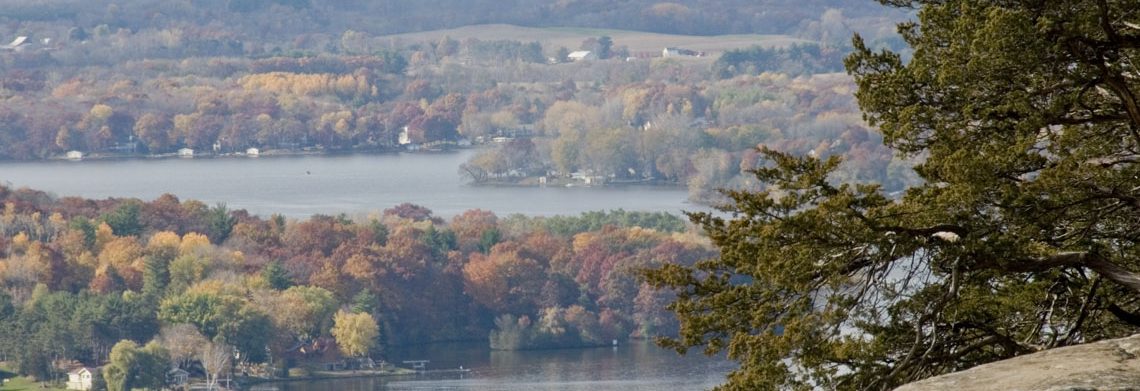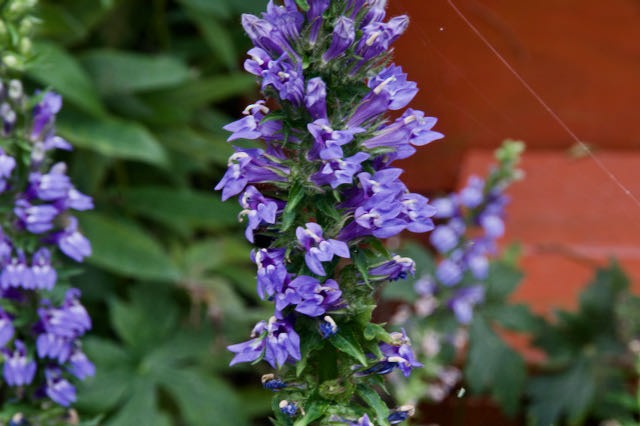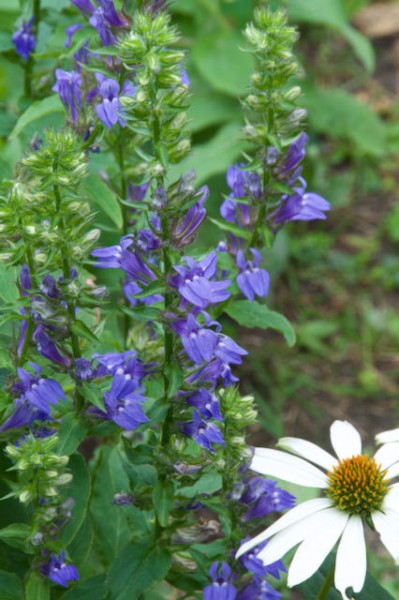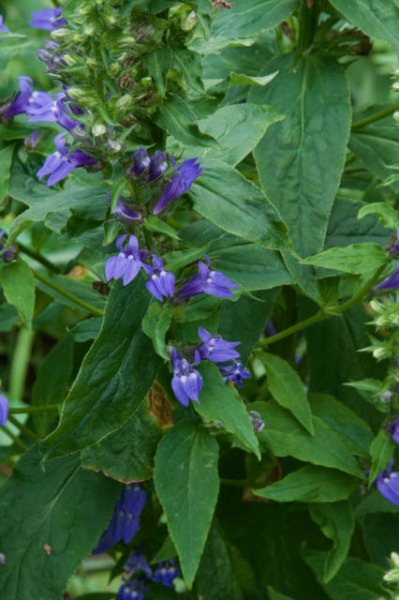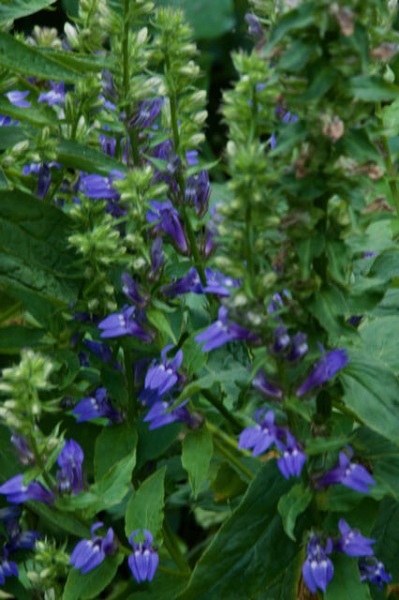great blue lobelia
Lobelia siphilitica
Description:
Sometimes called blue cardinal flower, great blue lobelia likes full sun but will tolerate partial shade. Plants grow from 1′-4′ tall. Blooms with multiples flowers on a single stalk from mid summer through fall. It wants medium to moist soil and does not tolerate drought. Often found in ditches or on wetland fens. Once established lobelia can form large patches. Each plant is a short lived perennial (with each plant living for only a few years).
Growing:
Great lobelia likes rich moist soils with plenty of humus. Plants can be divided in the early spring. Plants will grow from seed if given good growing conditions.
Warning:
All parts are poisonous. Toxic only if eaten in large quantities. Symptoms include nausea, vomiting, diarrhea, salivation, exhaustion and weakness, dilation of pupils, convulsions, and coma. Toxic Principle: Alkaloids lobelamine, lobeline, and others, plus a volatile oil. (Poisonous Plants of N.C.)
Details:
great blue lobelia
| USDA Symbol: | Common Name: | Scientific Name: |
|---|---|---|
| LOSI | great blue lobelia | Lobelia siphilitica |
ITIS TSN: 34531
Category: Dicot
Taxonomy
Kingdom: Plantae
Subkingdom:
Super Division: Spermatophyta
Division: Magnoliophyta
Subdivision:
Class: Magnoliopsida
SubClass: Asteridae
Order: Campanulales
Family: Campanulaceae
Counties: Barron, Brown, Buffalo, Burnett, Calumet, Clark, Columbia, Crawford, Dane, Dodge, Door, Dunn, Eau Claire, Fond du Lac, Grant, Green, Green Lake, Iowa, Iron, Jackson, Jefferson, Juneau, Kenosha, Kewaunee, La Crosse, Lafayette, Langlade, Lincoln, Manitowoc, Marathon, Marinette, Marquette, Menominee, Milwaukee, Monroe, Oconto, Outagamie, Ozaukee, Pepin, Pierce, Polk, portageprice, Racine, Richland, Rock, Rusk, Sauk, Sawyer, Shawano, Sheboygan, St. Croix, Taylor, Vernon, Walworth, Washburn, Washington, Waukesha, Waupaca, Waushara, Winnebago, Wood
| NR40 Listed Plant | Noxious Weed: | Invasive Species (NR40): | Threatened/Endangered: | WI Natural Heritage Index: | Wetland Status |
|---|---|---|---|---|---|
| Native | FACW |
Active Growth Period: spring-summer-fall
Carbon to Nitrogen Ratio:
Conspicuous Fall Color: Yes
Fire Resistant: No
Conspicuous Flower: Yes
Foliage Color: Green
Foliage Light Porosity Summer:
Fruit/Seed Color: Black
Growth Form: Single Stem
Height at Base Age (Max):
Known Alelopath: No
Leaf Retention: No
Re-sproutability:
Shape and Orientation: Erect
Toxicity: Moderate
Height (min): 12
Height (max): 48
Root Type: Fibrous
Leaf Type:
Leaf Arrangement:
Leaf Shape:
Vein Pattern:
Adapted to Coarse Textured Soils:
Adapted to Medium Textured Soils:
Adapted to Fine Textured Soils:
Drought Tolerance: Low
Hedge Tolerance: None
Moisture Use: Medium, High
pH (Minimum):
pH (Maximum):
Planting Density per Acre, Minimum:
Planting Density per Acre, Maximum:
Precipitation (Minimum):
Precipitation (Maximum):
Root Depth, Minimum (inches):
Shade Tolerance: Partial
Plant Spacing (min): 12
Plant Spacing (max): 12
| Bloom Period: | Commercial Availability: | Fruit/Seed Abundance: |
|---|---|---|
| Summer | Routinely Available | Medium |
| Fruit/Seed Period Begin: | Fruit/Seed Period End: | Fruit/Seed Persistence: |
|---|---|---|
| Summer | Fall | Yes |
| Propogated by Bare Root: | Propogated by Bulbs: | Propogated by Container: |
|---|---|---|
| No | No | Yes |
| Propogated by Corms: | Propogated by Cuttings: | Propogated by Seed: |
|---|---|---|
| No | No | Yes |
| Propogated by Sod: | Propogated by Sprigs: | Propogated by Tubers: |
|---|---|---|
| No | No | No |
| Seeds per Pound: | Seed Spread Rate: | Seedling Vigor: |
|---|---|---|
| 7520000 | Moderate |
| Small Grain: | Vegetative Spread Rate: | Propagation Treatment: |
|---|---|---|
| No | Moist Stratification |
| Days to Stratify: | Direct Sowing Time: |
|---|---|
| 30 |
Benefits: Birds, Butterflies, Deer Resistant, Host Plant, Hummingbirds, Pollinators
| Berry/Nut/Seed Product: | Christmas Tree Product: | Fodder Product: |
|---|---|---|
| No | No | No |
| Fuelwood Product: | Lumber Product: | Naval Store Product: |
|---|---|---|
| -- | No | No |
| Nursery Stock Product: | Palatable Browse Animal: | Palatable Graze Animal: |
|---|---|---|
| No | -- | -- |
| Palatable Human: | Post Product: | Protein Potential: |
|---|---|---|
| No | No | -- |
| Pulpwood Product: | Veneer Product: |
|---|---|
| No | No |
| Benefits: | Wildlife Food Value: | Wildlife Cover Value: |
|---|---|---|
| Birds, Butterflies, Deer Resistant, Host Plant, Hummingbirds, Pollinators |
Locations:
WisFlora Database detailed list of herbarium samples collected across Wisconsin including the location of each.
References:
USDA Plants Database
Wisconsin Virtual Flora Database
Lady Bird Johnson Wildflower Center
